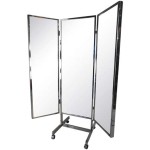Standard Full Length Mirror Sizes In Cm Chart
Full-length mirrors are essential elements in interior design, serving both functional and aesthetic purposes. They allow individuals to assess their complete image, adding depth and light to rooms. Understanding the standard sizes of full-length mirrors in centimeters is crucial for interior designers, homeowners, and retailers, ensuring appropriate selection for different spaces and purposes. This article provides a comprehensive overview of standard full-length mirror sizes in centimeters, exploring the factors influencing size selection.
The term "full-length mirror" generally refers to a mirror large enough for a person to see their entire reflection without bending or crouching. While there's no universally fixed definition, specific dimensions have emerged as industry standards to cater to typical human height and room proportions. These standard sizes simplify the shopping process and ensure that mirrors meet the expectations of a broad range of consumers.
Mirrors are typically manufactured and sold in both metric (centimeters) and imperial (inches) units. However, understanding the dimensions in centimeters is particularly important for international buyers or those who prefer metric measurements for interior design and planning. The following sections detail the common standard sizes encountered in the market.
Common Standard Full-Length Mirror Sizes in Centimeters
Several standard sizes are prevalent in the full-length mirror market. These sizes cater to diverse needs, from fitting into small apartments to adorning spacious dressing rooms. Each size offers a distinct visual impact and functional advantage.
One of the most common full-length mirror sizes is approximately 165 cm to 170 cm in height. This range adequately accommodates individuals of average height, allowing for a complete head-to-toe reflection. The width typically ranges from 30 cm to 45 cm, providing sufficient viewing area without overwhelming the space. Mirrors of this size are frequently used in bedrooms, bathrooms, and entryways.
Another popular size is around 150 cm in height and 40 cm in width. This slightly shorter option is well-suited for smaller spaces or for individuals who prefer a less imposing mirror. It still offers a full-body reflection, though with less peripheral visibility. This size is often chosen for dorm rooms, compact apartments, or areas with limited wall space.
Larger full-length mirrors can reach heights of 180 cm to 200 cm and widths of 60 cm or more. These mirrors are often used in high-end dressing rooms, retail stores, and dance studios, where a wider field of vision is desired. They create a dramatic visual impact and can make a room appear larger and more open.
While these are common sizes, it's important to note that manufacturers may offer variations. Additionally, custom mirror sizes can be ordered to precisely fit specific requirements or design concepts. When considering a custom size, factors such as the intended use, available wall space, and overall aesthetics should be carefully evaluated.
To synthesize these dimensions in a tabular format, consider the following chart:
Standard Full-Length Mirror Sizes (Approximate)
| Size Category | Height (cm) | Width (cm) | Typical Usage | |---|---|---|---| | Small | 150 | 40 | Dorm rooms, small apartments | | Medium | 165-170 | 30-45 | Bedrooms, bathrooms, entryways | | Large | 180-200 | 60+ | Dressing rooms, retail stores, dance studios |
This chart offers a general guideline. Specific product dimensions may vary depending on the manufacturer and design.
Factors Influencing Full-Length Mirror Size Selection
Selecting the appropriate full-length mirror size requires careful consideration of several factors. These considerations ensure the mirror is both functional and aesthetically pleasing within the intended space.
The first and most obvious factor is the available space. The size of the room and the amount of free wall space will dictate the maximum acceptable mirror dimensions. In small rooms, a large mirror can be overwhelming and visually shrink the space further. Conversely, a small mirror in a large room may appear insignificant and fail to make a significant impact. Careful measurement and planning are crucial to ensure the mirror is proportional to the room's dimensions.
The intended use of the mirror is another critical factor. If the mirror is primarily for checking outfits, a standard full-length size is generally sufficient. However, if the mirror is intended for activities such as dance or yoga, a larger size that provides a wider field of vision may be necessary. In retail environments, the size of the mirror should be appropriate for showcasing clothing and allowing customers to fully assess their appearance.
The overall aesthetic of the room should also be considered. The mirror's size and style should complement the existing décor and create a cohesive visual effect. A modern, minimalist room may benefit from a sleek, frameless mirror, while a more traditional room may call for a mirror with an ornate frame. The size of the mirror should be proportionate to other decorative elements in the room, such as furniture and artwork.
Finally, the height of the individuals who will be using the mirror should be taken into account. While standard sizes are designed to accommodate average heights, taller or shorter individuals may require a different size to ensure a complete reflection. Adjusting the mounting height can also compensate for minor height differences.
Mounting Options and Their Impact on Perceived Size
The mounting option chosen for a full-length mirror can significantly impact its perceived size and overall visual effect. Different mounting methods create different spatial relationships and influence how the mirror integrates into the room.
Wall-mounted mirrors offer a clean and streamlined look. They are typically hung flush against the wall, maximizing floor space and creating a sense of spaciousness. When mounting a mirror on the wall, it's essential to ensure it is securely fastened to prevent accidents. The height at which the mirror is mounted should also be carefully considered to ensure it is at the appropriate level for viewing.
Floor-standing mirrors, also known as cheval mirrors, are supported by a frame or stand and can be moved around the room as needed. These mirrors offer flexibility and can be a statement piece in a room. However, they also take up floor space, which may be a concern in smaller rooms. When choosing a floor-standing mirror, ensure the base is stable and the mirror is properly balanced to prevent tipping.
Over-the-door mirrors are a space-saving option that is particularly useful in small apartments or dorm rooms. These mirrors hang on the back of a door, utilizing otherwise unused space. While convenient, over-the-door mirrors may not be as stable as wall-mounted or floor-standing options. It's important to choose a mirror with a secure mounting system to prevent it from falling.
Integrated mirrors, such as those found in wardrobes or closet doors, offer a seamless and integrated look. These mirrors are typically custom-fitted to the door and provide a full-length reflection without taking up additional space. Integrated mirrors are a good option for maximizing space and creating a clean, minimalist aesthetic.
The choice of mounting option will depend on the available space, the desired aesthetic, and the functional requirements of the mirror. By carefully considering these factors, it's possible to select a mounting option that enhances the mirror's appearance and maximizes its utility.
In summary, understanding the standard full-length mirror sizes in centimeters is essential for effective interior design and product selection. The common sizes range from approximately 150 cm to 200 cm in height, with widths varying from 30 cm to 60 cm or more. Selecting the appropriate size requires careful consideration of the available space, intended use, overall aesthetic, and mounting options. By taking these factors into account, individuals can choose a full-length mirror that is both functional and visually appealing.

What Are The Standard Mirror Sizes Cm

Wall Hung Rectangular Full Length Dressing Mirror Led Lights Touch Sensor Backlit Bathroom Bath With Smart Makeup Made In China Com

What Is The Best Bathroom Mirror Height Cm

How To Measure Your Space For A Large Wall Mirror 2 Steps

Bathroom Mirror Size Calculator

What Is The Best Bathroom Mirror Size Calculator In Vanity Sizes

Buy Walter Sheesham Wood Full Length Dressing Mirror Walnut Finish 21 Off Wooden Street

Standard Sizes And Dimensions Of Home Furniture Engineering Discoveries

Xramfy 70 In H X 30 W Classic Arched Black Aluminum Alloy Framed Full Length Mirror Standing Floor Omacsc3070 Bk The Home Depot

How To Choose The Best Size Mirror Olde Good Things








